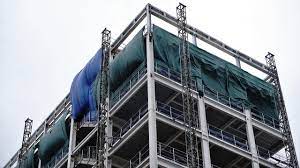In the realm of real estate projects, where timelines, budgets, and quality are paramount, the efficient use of materials and resources is crucial. Tarpaulins, often overlooked in this context, can play a significant role in streamlining construction processes, protecting assets, and maximizing project outcomes. This article explores how tarpaulins can be invaluable tools in real estate projects, enhancing efficiency, safeguarding materials, and providing temporary shelter.
Weather Protection:
Real estate projects often face the challenge of adverse weather conditions, such as rain, snow, or intense sunlight. Tarpaulins, with their water-resistant and UV-resistant properties, act as shields against inclement weather. They can cover exposed areas, protect construction materials, and prevent moisture damage, reducing the risk of delays and costly repairs caused by weather-related setbacks.
Construction Site Safety:
Safety is a top priority in any construction project. Tarpaulins contribute to maintaining a safe working environment by creating barriers and enclosures. They can be utilized to cordon off hazardous areas, preventing unauthorized access and minimizing the risk of accidents. Tarpaulins also serve as visual warnings, highlighting potential dangers and ensuring compliance with safety regulations.
Dust and Debris Control:
During construction, dust and debris can pose challenges, impacting air quality and neighboring properties. Tarpaulins serve as effective containment barriers, confining dust and debris within construction sites. By minimizing the spread of particles, tarpaulins contribute to a cleaner and healthier working environment, reducing health risks and potential disputes with adjacent properties.
Asset Protection:
Real estate projects involve a multitude of valuable assets, including construction materials, machinery, and equipment. Tarpaulins offer reliable protection, shielding these assets from damage caused by weather, dust, or accidental impact. Covering materials such as steel, wood, or delicate finishes ensures their integrity, reduces waste, and safeguards investments.
Temporary Shelter and Enclosures:
Tarpaulins possess inherent flexibility, allowing their use in creating temporary shelters and enclosures. In real estate projects, they can serve as construction site offices, storage areas, or on-site workshops. These cost-effective structures provide convenience, mobility, and adaptability, accommodating changing project needs without the complexities associated with permanent constructions.
Exterior and Façade Maintenance:
Maintaining the aesthetics and functionality of buildings during construction or renovation projects is essential. Tarpaulins act as protective barriers, enabling work to be carried out on exterior facades while shielding the rest of the structure. They prevent damage to windows, finishes, and delicate surfaces, allowing for a seamless transition from construction to the final stages of a project.
Versatile and Reusable Solutions:
Tarpaulins offer versatility in their applications, making them indispensable throughout the lifecycle of a real estate project. They can be customized to fit specific requirements, whether it’s covering large areas, creating partitions, or wrapping irregularly shaped objects. Additionally, tarpaulins are reusable, reducing waste and contributing to sustainable construction practices.
FAQs: Tarpaulins in Real Estate Projects
Q1: How do tarpaulins protect construction materials from adverse weather?
A1: Tarpaulins are water-resistant and UV-resistant, providing a protective barrier against rain, snow, and intense sunlight. By covering exposed areas and materials, they prevent moisture damage and minimize the risk of weather-related delays or costly repairs.
Q2: How can tarpaulins contribute to construction site safety?
A2: Tarpaulins can be used to create barriers and enclosures, cordoning off hazardous areas and restricting unauthorized access. They act as visual warnings, highlighting potential dangers and ensuring compliance with safety regulations.
Q3: How do tarpaulins help control dust and debris on construction sites?
A3: Tarpaulins act as containment barriers, confining dust and debris within construction sites. By minimizing the spread of particles, they contribute to a cleaner and healthier working environment, reducing health risks and potential disputes with neighboring properties.
Q4: How can tarpaulins protect valuable construction assets?
A4: Tarpaulins offer reliable protection by shielding construction materials, machinery, and equipment from weather, dust, and accidental damage. By covering these assets, tarpaulins ensure their integrity, reduce waste, and safeguard investments.
Q5: How can tarpaulins be used for temporary shelters and enclosures?
A5: Tarpaulins are versatile and can be used to create temporary structures such as construction site offices, storage areas, or on-site workshops. These structures offer convenience, mobility, and adaptability to accommodate changing project needs.
Q6: How do tarpaulins assist in exterior and façade maintenance during construction?
A6: Tarpaulins act as protective barriers, allowing work to be carried out on exterior facades while safeguarding the rest of the structure. They prevent damage to windows, finishes, and delicate surfaces, ensuring a seamless transition from construction to the final stages of the project.
Q7: Are tarpaulins reusable and environmentally friendly?
A7: Yes, tarpaulins are reusable and contribute to sustainable construction practices by reducing waste. They can be customized to fit specific project requirements, and their durability ensures they can be used across multiple projects.
Q8: What distinguishes HDPE Laminated Tarpaulin Manufacturers from other tarpaulin suppliers?
A8: HDPE Laminated Tarpaulin Manufacturers stand out for their remarkable product quality and unmatched durability. They use virgin polyethylene material and offer protection against stains, acids, and dyes. Their tarpaulins are easily repairable and cost-effective, and they excel in creating temporary shelters or tents. Choose HDPE Laminated Tarpaulin Manufacturers for superior tarpaulin solutions in real estate projects.
Conclusion:
From protecting assets and materials to ensuring site safety and facilitating efficient project management, tarpaulins play a pivotal role in real estate projects. Their versatility, durability, and cost-effectiveness make them indispensable tools for construction professionals seeking to optimize project outcomes. By harnessing the potential of tarpaulins, real estate developers and contractors can enhance productivity, minimize risks, and achieve successful project delivery. Embracing these unassuming yet invaluable resources is a step towards unlocking the full potential of real estate projects.





